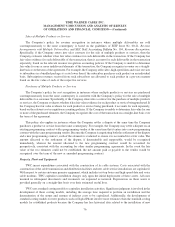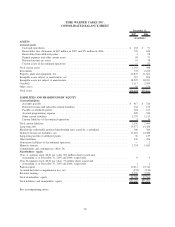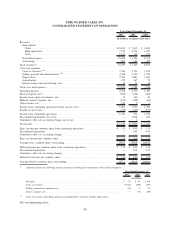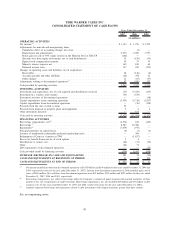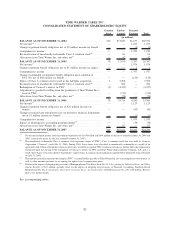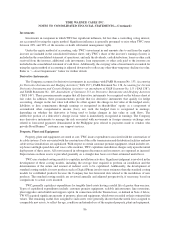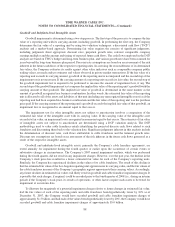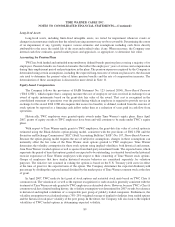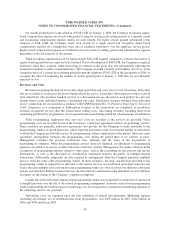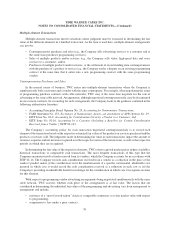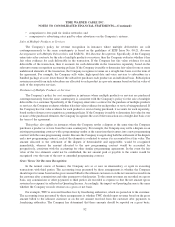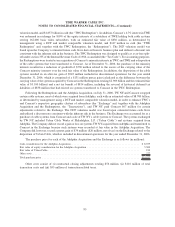Time Warner Cable 2007 Annual Report Download - page 91
Download and view the complete annual report
Please find page 91 of the 2007 Time Warner Cable annual report below. You can navigate through the pages in the report by either clicking on the pages listed below, or by using the keyword search tool below to find specific information within the annual report.Investments
Investments in companies in which TWC has significant influence, but less than a controlling voting interest,
are accounted for using the equity method. Significant influence is generally presumed to exist when TWC owns
between 20% and 50% of the investee or holds substantial management rights.
Under the equity method of accounting, only TWC’s investment in and amounts due to and from the equity
investee are included in the consolidated balance sheet; only TWC’s share of the investee’s earnings (losses) is
included in the consolidated statement of operations; and only the dividends, cash distributions, loans or other cash
received from the investee, additional cash investments, loan repayments or other cash paid to the investee are
included in the consolidated statement of cash flows. Additionally, the carrying value of investments accounted for
using the equity method of accounting is adjusted downward to reflect any other-than-temporary declines in value.
Refer to “—Asset Impairments” below for further details.
Derivative Instruments
The Company accounts for derivative instruments in accordance with FASB Statement No. 133, Accounting
for Derivative Instruments and Hedging Activities (“FAS 133”), FASB Statement No. 138, Accounting for Certain
Derivative Instruments and Certain Hedging Activities—an amendment of FASB Statement No. 133 (“FAS 138”),
and FASB Statement No. 149, Amendment of Statement 133 on Derivative Instruments and Hedging Activities
(“FAS 149”). These pronouncements require that all derivative instruments be recognized on the balance sheet at
fair value. In addition, these pronouncements provide that for derivative instruments that qualify for hedge
accounting, changes in the fair value will either be offset against the change in fair value of the hedged assets,
liabilities or firm commitments through earnings or recognized in shareholders’ equity as a component of
accumulated other comprehensive income (loss), net, until the hedged item is recognized in earnings,
depending on whether the derivative is being used to hedge changes in fair value or cash flows. The
ineffective portion of a derivative’s change in fair value is immediately recognized in earnings. The Company
uses derivative instruments to manage the risk associated with movements in foreign currency exchange rates
related to forecasted payments denominated in the Philippine peso related to payments made to vendors who
provide Road Runner
TM
customer care support services.
Property, Plant and Equipment
Property, plant and equipment are stated at cost. TWC incurs expenditures associated with the construction of
its cable systems. Costs associated with the construction of the cable transmission and distribution facilities and new
cable service installations are capitalized. With respect to certain customer premise equipment, which includes set-
top boxes and high-speed data and voice cable modems, TWC capitalizes installation charges only upon the initial
deployment of these assets. All costs incurred in subsequent disconnects and reconnects are expensed as incurred.
Depreciation on these assets is provided generally on a straight-line basis over their estimated useful lives.
TWC uses standard costing models to capitalize installation activities. Significant judgment is involved in the
development of these costing models, including the average time required to perform an installation and the
determination of the nature and amount of indirect costs to be capitalized. Additionally, the development of
standard costing models for new products such as Digital Phone involve more estimates than the standard costing
models for established products because the Company has less historical data related to the installation of new
products. The standard costing models are reviewed annually and adjusted prospectively, if necessary, based on
comparisons to actual costs incurred.
TWC generally capitalizes expenditures for tangible fixed assets having a useful life of greater than one year.
Types of capitalized expenditures include: customer premise equipment, scalable infrastructure, line extensions,
plant upgrades and rebuilds and support capital. In connection with the Transactions, as defined in Note 4 below,
TW NY acquired significant amounts of property, plant and equipment, which were recorded at their estimated fair
values. The remaining useful lives assigned to such assets were generally shorter than the useful lives assigned to
comparable new assets, to reflect the age, condition and intended use of the acquired property, plant and equipment.
86
TIME WARNER CABLE INC.
NOTES TO CONSOLIDATED FINANCIAL STATEMENTS—(Continued)


